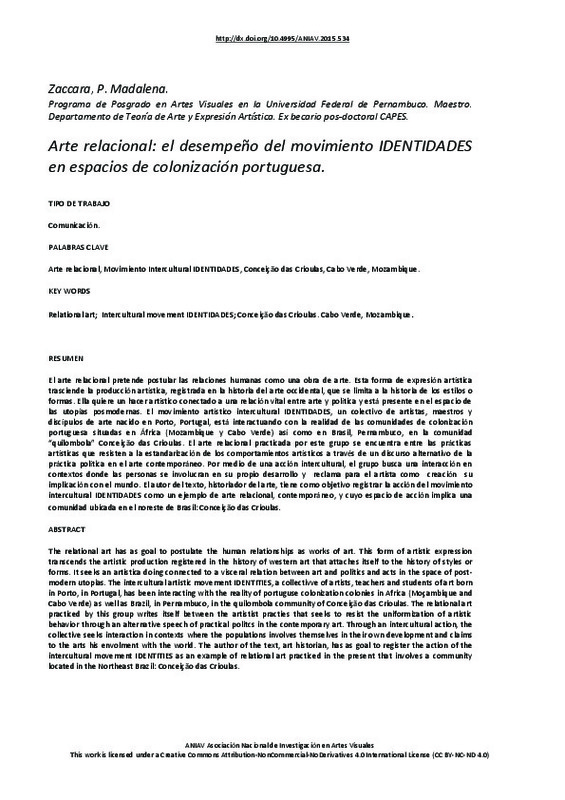|
Resumen:
|
[EN] The relational art has as goal to postulate the human relationships as works of art. This form of artistic expression transcends the artistic production registered in the history of western art that attaches itself ...[+]
[EN] The relational art has as goal to postulate the human relationships as works of art. This form of artistic expression transcends the artistic production registered in the history of western art that attaches itself to the history of styles or forms. It seeks an artistica doing connected to a visceral relation between art and politics and acts in the space of post--‐ modern utopias. The intercultural artistic movement IDENTITIES, a collectivve of artists, teachers and students of art born in Porto, in Portugal, has been interacting with the reality of portuguse colonization colonies in Africa (Moçambique and Cabo Verde) as well as Brazil, in Pernambuco, in the quilombola community of Conceição das Crioulas. The relational art practiced by this group writes itself between the artistist practies that seeks to resist the uniformization of artistic behavior through an alternative speech of practical politcs in the contemporary art. Through an intercultural action, the collective seeks interaction in contexts where the populations involves themselves in their own development and claims to the arts his envolment with the world. The author of the text, art historian, has as goal to register the action of the intercultural movement IDENTITIES as an example of relational art practiced in the present that involves a community located in the Northeast Brazil: Conceição das Crioulas.
[-]
[ES] El arte relacional pretende postular las relaciones humanas como una obra de arte. Esta forma de expresión artística trasciende la producción artística, registrada en la historia del arte occidental, que se limita a ...[+]
[ES] El arte relacional pretende postular las relaciones humanas como una obra de arte. Esta forma de expresión artística trasciende la producción artística, registrada en la historia del arte occidental, que se limita a la historia de los estilos o formas. Ella quiere un hacer artístico conectado a una relación vital entre arte y política y está presente en el espacio de las utopías posmodernas. El movimiento artístico intercultural IDENTIDADES, un colectivo de artistas, maestros y discípulos de arte nacido en Porto, Portugal, está interactuando con la realidad de las comunidades de colonización portuguesa situadas en África (Mozambique y Cabo Verde) así como en Brasil, Pernambuco, en la comunidad “quilombola” Conceição das Crioulas. El arte relacional practicada por este grupo se encuentra entre las prácticas artísticas que resisten a la estandarización de los comportamientos artísticos a través de un discurso alternativo de la práctica política en el arte contemporáneo. Por medio de una acción intercultural, el grupo busca una interacción en contextos donde las personas se involucran en su propio desarrollo y reclama para el artista como creación su implicación con el mundo. El autor del texto, historiador del arte, tiene como objetivo registrar la acción del movimiento intercultural IDENTIDADES como un ejemplo de arte relacional, contemporáneo, y cuyo espacio de acción implica una comunidad ubicada en el noreste de Brasil: Conceição das Crioulas.
[-]
|








